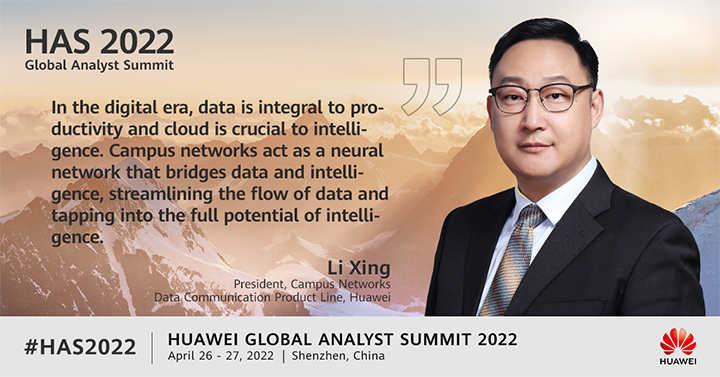このサイトはCookieを使用しています。 サイトを閲覧し続けることで、Cookieの使用に同意したものとみなされます。 プライバシーポリシーを読む>
![]()
このサイトはCookieを使用しています。 サイトを閲覧し続けることで、Cookieの使用に同意したものとみなされます。 プライバシーポリシーを読む>
![]()
企業ユーザー向け製品、ソリューション、サービス
[Shenzhen, China, April 27, 2022] At the Huawei Global Analyst Summit 2022 (HAS 2022), Huawei put forward the value proposition of the next-generation campus network landscape: all-gigabit access, simplified and low-carbon network architecture, hyper-converged branch interconnection, and intelligent network O&M. This move cements Huawei's commitment to accelerating the digital transformation of enterprise campuses.

Dr. Li Xing, President of Campus Network Domain, Huawei's Data Communication Product Line, outlines the value proposition of the next-generation campus network industry
The rise of emerging technologies — such as cloud, IoT, and big data — is extending enterprise digitalization from workplaces to production and operation spaces, and from HQ to branches and clouds. Against this backdrop, enterprise campuses are expected to enable intelligent, collaborative office and production environments for improved team creativity and more agile collaboration. Beyond that, enterprise campuses need to accelerate cloud access for services, paving the way for global service collaboration amid the fast changing business environment.
Campus networks are the cornerstone of enterprise digital transformation, connecting clouds on one end and all things on the other end.
"In the digital era, data is integral to productivity and cloud is crucial to intelligence," said Dr. Li Xing, President of Campus Network Domain, Huawei's Data Communication Product Line. "Campus networks act as a neural network that bridges data and intelligence, streamlining the flow of data and tapping into the full potential of intelligence."
Traditional campus networks face many challenges such as discontinuous wireless networking, complex network architecture, difficult cloud access for branches, and low O&M efficiency. To address these challenges and pave the way for future digital construction of enterprises, Huawei proposed the concept of a next-generation campus network that redefines campus access, architecture, branch, and O&M.
• Redefining campus access: WLAN has become the first-choice wireless access mode for enterprises. As a major contributor to Wi-Fi standards, Huawei redefines campus network access with its full lineup of AirEngine products. In particular, Huawei's Wi-Fi 6 Advanced technical framework — a key milestone before Wi-Fi 7 becomes the norm — stands out with three unique features: network-wide gigabit, real-time intelligent control, and harmonized IoT and sensing. With these traits, Wi-Fi 6 Advanced is ideal for building speedy, stable, and smart fully-wireless networks.
• Redefining campus architecture: Huawei innovates an all-new campus network architecture with four new features: simplified, low-carbon, secure, and one-network. This new architecture slashes the managed nodes by 87% and reduces the energy consumption of the entire network by 30%. It also enables wired, wireless, office, production, and IoT services to be carried on one network, while ensuring services are securely isolated and running stably by using technologies such as VXLAN, network slicing, and iConnect 3.0.
• Redefining campus branches: Huawei's SD-WAN solution redefines enterprise branch networks by enabling secure and premium multi-cloud, multi-branch interconnection. As cloud technologies become more widely adopted, a myriad of enterprise services are migrated to the cloud, with such services being highly dynamic. Huawei responds to this by proposing a cloud-native SD-WAN solution that enables on-demand network subscription by function, performance, or capacity anytime, anywhere. In addition, with the ongoing network cloudification, branch-to-cloud security faces unprecedented challenges. Huawei SD-WAN addresses these challenges by centrally deploying professional security protection in the headquarters or on the cloud while fully leveraging local branch security functions. In this way, enterprises can benefit from comprehensive security assurance.
• Redefining campus O&M: Huawei takes the lead in implementing L3 autonomous driving campus networks that redefine O&M. To elaborate, Huawei's solution breaks the limits of manual management and enables the proliferating terminals to access the network and enjoy consistent experience. It also breaks network boundaries and ensures unified O&M across WLAN, LAN, and WAN. Other highlights include breaking the heavy reliance on high skills and enabling full-lifecycle digital management.